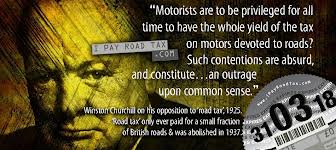The Myth of “Road Tax”
Taken from the Blazing Saddles Column in the Tayside Courier Weekend Supplement 23.6.12
Scot Tares finds that cycling to work doesn’t have to be taxing.
“There has been no direct relationship between vehicle tax and road expenditure since 1937.”
Policy and External Communications Directorate, Driver and Vehicle Licensing Agency (DVLA)
Why don’t cyclists pay Road Tax? It’s a common misconception ingrained into our culture and psyche, and even MPs and the national media have got it wrong. The concept of road tax does not now actually exist after a process, instigated by Winston Churchill in 1926, led to motorists making the last “Road Fund” payments in 1937. Indeed, the maintenance and development of the road infra-structure is now paid for by general and local taxation that we all contribute to and the “tax disc” on a car is actually a Vehicle Excise Duty (VED) and cars are graded from Band A (up to 100g per km of CO2 emissions) right up to Band M (over 255g per km). A vehicle in the Band A grade is exempt from VED and according to the Society of Motor Manufacturers and Traders there are currently 65,000 such vehicles on the UK’s roads and this is rising quickly; because of this it is likely that the government will reduce the threshold limit further still.
Certainly this puts the claim that cyclists should pay “road tax” in a different light; producing 0g CO2 per kilometre a bicycle would be eligible for Band A, making it exempt from charge, along with the two million other exempt vehicles (including disabled drivers and police cars amongst others). Furthermore, the cost of registration and duty compliance would be borne by motorists who currently fall out-with Band A as they picked up the tab for the 25 million exempt bicycles that would need a VED disc under such a scheme.
Commuting by bike may not seem like an option for many of the Scottish population, but for a vast number of people the use of a bike, even out-with the larger population centres, makes a lot of sense. Scottish Development International estimate “the average commuting distance across Scotland is between five and six kilometres with almost 90 percent of workers living within 25 kilometres of their workplace.”
Just think of the knock-on benefits of even 5% of that number commuting by bike at least once a week: the roads would be less congested, less traffic would mean less wear and tear on the road infrastructure and people being more active would lead to a healthier population. Across the world, major cities are embracing the bicycle as an essential mode of transport in their efforts to develop and grow while keeping one eye on the environmental impact of expansion. This further enhances the culture and lifestyle of the people who live there, and with Dundee looking towards a vibrant future it would be remiss if the bicycle did not become part of a confident, sustainable and progressive growth of the city and have a positive impact on the lives of those who live there.
Over the next few weeks I will be discussing the benefits of commuting to work by bicycle and looking how it has become part of everyday life for millions. This week’s route looks at a commute from the western bounds of Dundee, right into the heart of the city.
Scot Tares
Cycle Route – Perth Road, Dundee
| Where: | Perth Road, Dundee |
| Distance: | 3.1 miles |
| Elevation: | 98ft |
| Description: | The Perth Road is a delightful link through Dundee; with Ninewells Hospital and the Technology Park at one end and a multitude of businesses and learning establishments along the way, right in to the city centre. It is really the perfect route for commuters that is accessible to thousands. |
Copyright DC Thompson 2012





